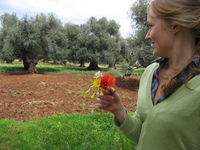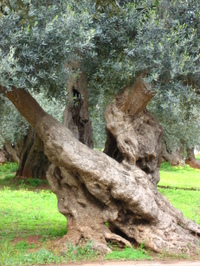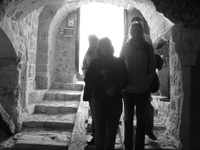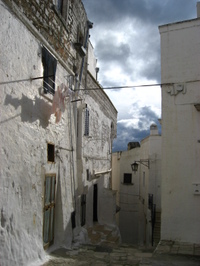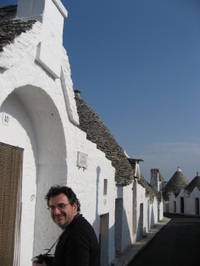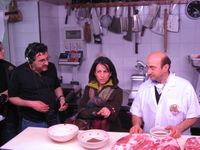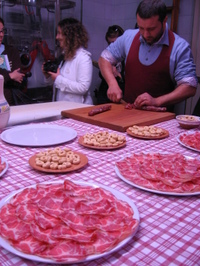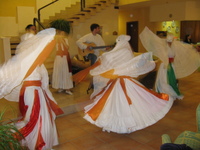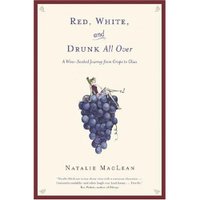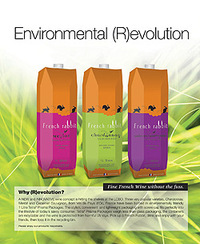 This posting for volume 34 of All You Can Eat is a work in progress, as I want to add some photo albums and video clips as I go along. So if everything isn't quite here yet, keep checking for the added content in a couple of days. The podcast takes you through part of my most recent field trip to Puglia. You will find a couple of other postings with photos here and here, so this one is meant to fill in some of the blanks not yet covered. The photo you see at the right is of a traditional Pugliese song and dance troupe that entertained us the first night we arrived at our hotel. They were truly energetic and had our class all up and dancing with them even before dinner and wine, so you know they were good. One of their specialties was the tarantella, a frenzied dance that was supposedly invented in the 16th century to help cure victims of tarantism, supposedly caused by tarantula spider bites. Here's a short video clip of one of the dances. And dinner was pretty good, too. Here's a captioned photo album of a few of the dishes we enjoyed that first night.
This posting for volume 34 of All You Can Eat is a work in progress, as I want to add some photo albums and video clips as I go along. So if everything isn't quite here yet, keep checking for the added content in a couple of days. The podcast takes you through part of my most recent field trip to Puglia. You will find a couple of other postings with photos here and here, so this one is meant to fill in some of the blanks not yet covered. The photo you see at the right is of a traditional Pugliese song and dance troupe that entertained us the first night we arrived at our hotel. They were truly energetic and had our class all up and dancing with them even before dinner and wine, so you know they were good. One of their specialties was the tarantella, a frenzied dance that was supposedly invented in the 16th century to help cure victims of tarantism, supposedly caused by tarantula spider bites. Here's a short video clip of one of the dances. And dinner was pretty good, too. Here's a captioned photo album of a few of the dishes we enjoyed that first night.
 Our last day in Puglia involved a lot of raw fish. Here is just one of the platters we were offered to eat at lunch. The squid and shrimp were fine…but the octopus. Well, I took too big a bite and I chewed and I chewed and I chewed, and then it started to get a little much for me so I ended up spitting it into my napkin as surreptitiously as possible. The other platter consisted of raw mussels and clams as well as two kinds of sea urchin, one 'regular' and one that was in the midst of spawning, to the roe was milky with a spermy-looking substance. The mussels and clams were sweet and fresh, but the urchin couldn't compare to the sweet, mango-like urchin I've had on the West Coast of Canada. Here is a clip of classmates Betsy and Daniel getting up close and personal with their mussels. Nice face, Betsy!
Our last day in Puglia involved a lot of raw fish. Here is just one of the platters we were offered to eat at lunch. The squid and shrimp were fine…but the octopus. Well, I took too big a bite and I chewed and I chewed and I chewed, and then it started to get a little much for me so I ended up spitting it into my napkin as surreptitiously as possible. The other platter consisted of raw mussels and clams as well as two kinds of sea urchin, one 'regular' and one that was in the midst of spawning, to the roe was milky with a spermy-looking substance. The mussels and clams were sweet and fresh, but the urchin couldn't compare to the sweet, mango-like urchin I've had on the West Coast of Canada. Here is a clip of classmates Betsy and Daniel getting up close and personal with their mussels. Nice face, Betsy!
 This box of unlikely looking seafood contains something the fishermen on the docks of Brindisi were calling 'white truffle of the sea'. Right. Not exactly to all tastes, including my own, it was very strong, but I managed to choke it down, even though what was inside the thick skin of the 'sea truffle' looked like a big ball of phlegm. I've put together a little sequence of my tasting of this seafood in this photo album. Photos by Betsy, thank you. I was using my still camera when she had her own try, and I think I caught her face just at the moment when she was struggling not to throw up her particular 'ball of phlegm'. Have to wait to have the photos developed…gee, what a concept in this age of digital technology.
This box of unlikely looking seafood contains something the fishermen on the docks of Brindisi were calling 'white truffle of the sea'. Right. Not exactly to all tastes, including my own, it was very strong, but I managed to choke it down, even though what was inside the thick skin of the 'sea truffle' looked like a big ball of phlegm. I've put together a little sequence of my tasting of this seafood in this photo album. Photos by Betsy, thank you. I was using my still camera when she had her own try, and I think I caught her face just at the moment when she was struggling not to throw up her particular 'ball of phlegm'. Have to wait to have the photos developed…gee, what a concept in this age of digital technology.
The first documentary you hear in this podcast is about olive trees in two different places, the Marche, and Puglia. Two quite different groves, with the most mystique, if I can call it that, about the trees in Puglia, a grove where the age of the average tree has been pegged at 500 years. Also just as fascinating, a trip underground to a subterranean olive oil mill…quite the undertaking for the time it was built, which was sometime before 1423. The people who restored the mill know this, since they managed to find a document from 1423 which detailed the expansion of this mill. When you think about it, it was a pretty remarkable feat of engineering to carve a cave out of solid rock that would fit 15 to 20 workers, a couple of horses or donkeys, and the olive mills and presses. Why underground? Apparently back then it was cheaper to dig than to build, easier to secure, lower, constant temperatures which were more conducive to making quality oil, and the presses could use the roof of the cave for support.
Here is a nice wide shot of part of the mill, but it is really much larger than what you can see in the photo. I've put together a photo album of Betsy's pictures of the olive grove and the mill, along with this short video clip of the mill owner showing how the press worked.
I also promised to repeat the tips about the purchase and storage of olive oil:
So how do you choose a good quality oil? If it says extra-virgin on the label, that means it is the first, cold pressing of the olives. UPDATE: In studying for my olive oil technology exam today, I realize the idea of first cold pressing is out of date. Because modern mills use a continuous centrifugal press, there is no second pressing of the olives. To read more about the grading and production of olive oil visit the Olive Oil Source. If you choose to purchase extra-virgin, then you need to smell and taste. Unfortunately, it’s not like going to a wine bar where you could try 3 or 4 different wines in an evening. Some gourmet grocery stores may have tasting stations and that’s a good start. An oil should smell fresh, perhaps grassy or fruity, not rancid. The taste is a personal discovery. Some people like oils with a real peppery finish that leaves a bite in the back of your throat. Others want something smoother. It depends on what you are using it for, dressing a salad, drizzling over some warm vegetables or garnishing a soup. Buy small bottles to start with until you find something you like. Keep your oil away from heat and light, and use it up within a few months. And remember, like wine, every year brings a different harvest and different flavours.




